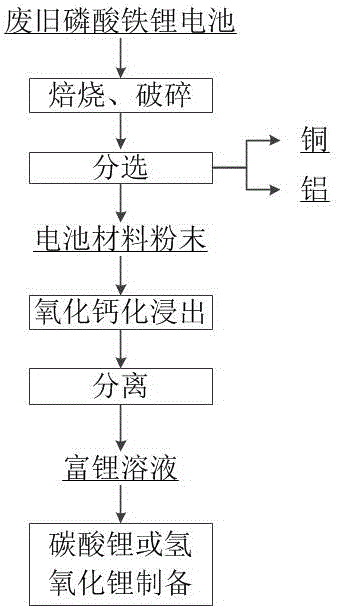Method for recovering lithium in waste and old lithium iron phosphate batteries
A lithium iron phosphate battery and lithium recovery technology, applied in battery recycling, waste collector recycling, recycling technology, etc., can solve the problems of large acid consumption, leachate containing impurities and high-salt wastewater, etc.
- Summary
- Abstract
- Description
- Claims
- Application Information
AI Technical Summary
Problems solved by technology
Method used
Image
Examples
Embodiment 1
[0037] (1) Break the positive electrode material of the waste lithium iron phosphate battery into pieces of 1~20mm×1~20mm, and roast at 800°C for 2 hours. During the roasting process, CaO can be sprayed to prevent the generation of fluorine-containing gas. The mass ratio of body is controlled at 300:1. After the calcination, metals such as aluminum and copper are removed by sieving to obtain lithium-containing powder.
[0038] Table 1 Composition of lithium-containing powder obtained by roasting and sorting lithium iron phosphate batteries (wt%)
[0039] Fe P Li 25.7 14.4 3.2
[0040] (2) The obtained positive electrode powder is added to the Ca(OH)-containing 2 Alkaline suspension, oxygen is introduced during the reaction (the volume ratio of oxidant / positive electrode powder solution is 10), iron and phosphate are converted into water-insoluble compounds, and lithium is converted into water-soluble lithium hydroxide . The mass concentration of calc...
Embodiment 2
[0044](1) Break the positive electrode material of the waste lithium iron phosphate battery into pieces of 1~20mm×1~20mm, and roast at 1000°C for 2 hours. During the roasting process, CaO can be sprayed to prevent the generation of fluorine-containing gas. The mass ratio of body is controlled at 300:1. After the calcination, metals such as aluminum and copper are removed by sieving to obtain lithium-containing powder.
[0045] Table 2 Composition of lithium-containing powder obtained by roasting and sorting lithium iron phosphate batteries (wt%)
[0046] Fe P Li 19.2 8.7 1.7
[0047] (2) The obtained positive electrode powder is added to the Ca(OH)-containing 2 Alkaline suspension, while adding KMnO 2 Solution (positive electrode powder solution / KMnO 2 Solution mass ratio 20, KMnO 2 The solution concentration is 10%), converting iron and phosphate into water-insoluble compounds, and converting lithium into water-soluble lithium hydroxide. The mass ...
Embodiment 3
[0051] (1) Break the positive electrode material of the waste lithium iron phosphate battery into pieces of 1~20mm×1~20mm, roast at 1200°C for 2 hours, and spray CaCO during the roasting process 3 To prevent the generation of fluorine-containing gas, the mass ratio of battery waste to calcium-containing powder is controlled at 300:1. After the calcination, metals such as aluminum and copper are removed by sieving to obtain lithium-containing powder.
[0052] Table 3 Composition of lithium-containing powder obtained by roasting and sorting lithium iron phosphate batteries (wt%)
[0053] Fe P Li 23.1 10.5 2.1
[0054] (2) The obtained positive electrode powder is added to the Ca-containing solution, and H 2 o 2 Solution (positive electrode powder solution / H 2 o 2 Solution mass ratio 30, H 2 o 2 The solution concentration is 15%), converting iron and phosphate into water-insoluble compounds, and converting lithium into water-soluble lithium hydroxide...
PUM
 Login to View More
Login to View More Abstract
Description
Claims
Application Information
 Login to View More
Login to View More - R&D
- Intellectual Property
- Life Sciences
- Materials
- Tech Scout
- Unparalleled Data Quality
- Higher Quality Content
- 60% Fewer Hallucinations
Browse by: Latest US Patents, China's latest patents, Technical Efficacy Thesaurus, Application Domain, Technology Topic, Popular Technical Reports.
© 2025 PatSnap. All rights reserved.Legal|Privacy policy|Modern Slavery Act Transparency Statement|Sitemap|About US| Contact US: help@patsnap.com

